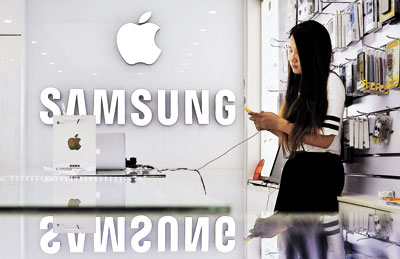|

SOUTH KOREAN firms have accelerated investment into China by a third this year, encouraged by improving diplomatic ties including a pending free trade deal.
The expansion in China by South Korean companies is in sharp contrast to Japanese firms, which have been rapidly scaling back investment following a territorial dispute two years ago and ongoing political spats.
Japan’s foreign direct investment (FDI) into China is 43 percent lower so far this year from 2013 at US$3.39 billion, while South Korea’s FDI into China jumped 33 percent during the first nine months of the year to US$3.23 billion.
The South Korean investment surge comes as Beijing and Seoul strengthen diplomatic ties, hoping to wrap up free trade talks by the end of the year. Chinese President Xi Jinping and South Korean President Park Geun-hye have met five times since both took office last year and will hold another bilateral summit next month on the sidelines of the Asia-Pacific Economic Cooperation forum in Beijing.
In contrast, Xi has yet to meet Japanese Prime Minister Shinzo Abe since both took power.
Heavyweights such as Samsung Electronics Co. Ltd. and Kia Motors Corp. have powered the investment drive by expanding production facilities in China, with manufacturing accounting for about 90 percent of total South Korean FDI to China.
But investment in the less capital-intensive wholesale/retail sector grew over 55 percent last year as consumer goods firms cashed in on a “Korean wave” fashion craze among younger Chinese for South Korean cultural products from music to cosmetics and clothing.
“Since the South Korean market is very small, Korean companies have to go overseas to survive,” said Hwang You-sun, deputy general manager at Korea Trade Investment Promotion Agency (Kotra) in Shanghai.
“Data has shown China’s economy is weakening because of industrial restructuring but Korean companies consider China’s internal demand to be big and thus are optimistic about the outlook.”
For example, Amorepacific Group Corp., South Korea’s largest cosmetics maker, is expanding its production and R&D center in Shanghai with a target to produce 13,000 tons annually by 2020, or 10 times what it makes now, said Kim Seung-hwan, senior vice president of group strategy.
South Korea is one of the few developed countries that has a trade surplus with China, its biggest export market.
Samsung invested US$7 billion to build a NAND flash memory factory in Xi’an in northwestern China, which began operations earlier this year, while South Korea’s Kia Motors began production at its third factory in China early this year.
While their contributions to South Korea’s overall FDI to China remain a small fraction of the total, consumer companies have expanded their presence in China helped by the popularity of South Korean television dramas, especially among young Chinese.
“The K-wave has been influential on Chinese, and it makes Chinese emotionally closer to South Korea than Japan,” said Ji-san Kim, an analyst covering South Korean makers of electronics and home appliances at Kiwoom Securities in Seoul.(SD-Agencies)
|

